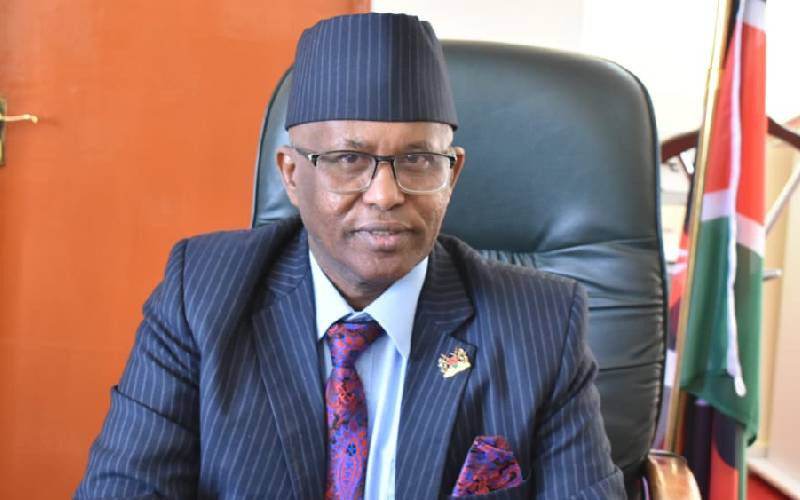At 11 am, I meet 31-year-old Hilder Wanjiru in her compound in Mau Narok, Likia location, Nakuru County with her second-born child who is almost twon and a half years old.
Even though he is old enough to have been able to chew, she is feeding him food that has been blended to a paste. Alex is among millions of children battling Cerebral palsy (CP), a group of disorders that affect a person's ability to move and maintain balance and posture, according to the Centres for Disease Control (CDC).
"I had Alex in 2021 through cesarean birth. He was healthy like any other newborn. Two weeks later, he got sick and took him to a nearby facility and diagnosed him with pneumonia. We were medicated and came back home but he developed a high fever and his condition got worse - to the point of refusing to breastfeed," says Hilder.
She narrates that doctors admitted her son to the hospital after they noticed that his body temperature was reading 41C. They suspected the child could have contracted meningitis but a CT scan showed this was not the case.
"We were given some medicine which medics said would bring his temperature down to normal. Back at home, as a mother, I suspected something was wrong with Alex. He was not as cheerful and active as the firstborn child," Hilder says.
She says that at 8 months when she checked the baby's eyes, she sensed something was amiss.
"He looked like someone who was blind - his vision was affected. I took him to hospital and after several tests, I was told he had Cerebral Palsy. Medics advised me to start introducing the child to therapies which was the only form of treatment available," Hilder narrates.
According to the CDC, cerebral palsy is the most common motor disability in childhood. It is caused by abnormal brain development or damage to the developing brain that affects a persons ability to control his or her muscles.
"The symptoms of CP vary from person to person. A person with severe CP might need to use special equipment to be able to walk, or might not be able to walk at all and might need lifelong care. A person with mild CP, on the other hand, might walk a little awkwardly, but might not need any special help. This disorder does not get worse over time, though the exact symptoms can change over a person's lifetime," the CDC says.
"The most common type of CP is spastic CP. It affects about 80 per cent of people with this disorder," CDC says.
The organisation lists the signs of CP as varying greatly because there are many different types and levels of disability. The main sign that a child might have is a delay reaching motor or movement milestones such as rolling over, sitting, standing, or walking.
"All people with this condition including children have problems with movement and posture. Many also have related conditions such as intellectual disability, seizures; problems with vision, hearing, or speech; changes in the spine (such as scoliosis); or joint problems (such as contractures)," the CDC adds.
According to the Cerebral Palsy Alliance Research Foundation, there is no single cause of CP, though prematurity and stroke are two of the biggest causes.
"While the personal cause remains unknown for most cerebral palsy cases, researchers now know that only a tiny percentage of cerebral palsy cases arise from birth-related complications, such as lack of oxygen. It is scientifically accepted that cerebral palsy usually arises from a series of causal pathways - sequences of events that combine to cause or accelerate injury to the developing brain," explains the foundation.
Hilder says that raising a child with cerebral palsy comes with a lot of challenges for parents and caregivers.
Stay informed. Subscribe to our newsletter
"Medics told me that my son's vision was affected by this disorder. Imagine raising a child who cannot see. It's a very tricky life," Hilder says.
At two years and five months, Alex cannot walk, talk, chew food or sit up on his own.
"I go to hospitals now and again, either for therapy sessions or other health complications which come in when a child is having CP," she adds.
"I used to work but now I'm jobless because I have no one to leave my child with. Here in Mau Narok, most people depend on casual work to make ends meet," she says.
"If I try to take the casual work, say on a farm, I have to carry the child no matter the distance or place. I would have two duties to carry out - caring for the child and doing the work. This discourages employers and next time they will not give you the job," Hilder says.
She adds that even though she is supposed to take her child for regular therapy sessions, she is unable to do so because she cannot afford the means to commute.
"I have debts all over. I'm sure when I'll settle them. I end up asking my friends to help me pay medical bills and buy food. Where else can I get the money? I'm jobless - not because there's no job," Hilder says.
She says that feeding her child is not easy because he cannot chew his food by himself. She has to mash the food and feed him.
"This always takes time- A child with CP is not like any other child who could feed himself or herself," she says.
She adds that those with severe gastrointestinal system complications may require complicated interventions to support their nutrition such as feeding tubes, which can be quite intimidating to potential caregivers.
She adds that some people associate the condition with witchcraft.
"Since I gave birth to Alex, I've been facing stigma either from my family, relatives and even friends. My child is considered as a curse therefore parents including me are sometimes forced to keep the children away from the public," she says.
Catherine Ndunda is another parent who has been nursing a child with cerebral palsy for four years.
"The therapy sessions used to be Sh 200 but now it is Sh 500. I'm supposed to take my child there three to four times a week which is quite costly for the ordinary citizen," says Catherine who is 40 years old and a resident of Nairobi.
She narrates that she had to cut communication with her in-laws because they believed that her child had cerebral palsy because she came from a 'devil worshipper' family.
"A child with cerebral palsy cannot use the toilet so I have to dress my child in diapers every day. It is so expensive. He uses four diapers daily and each diaper costs Sh30 ," Catherine says.
"My child has a right to an education and is supposed to be enrolled in a school like any other child. I have been to several schools to try my luck but, so far, none of the schools I have visited can care for my son as he can't walk or stand on his own without support," Catherine says. Hilder says being a caregiver takes a toll on her emotionally.
"The pain and trauma of seeing your child not reaching milestones such as sitting, walking and talking is unbearable. It usually leads to depression and mental breakdowns. These children suffer low muscle tone which makes feeding and swallowing difficulties so there's the extra burden of feeding them through a tube, "Hilder says. "I cry a lot and sometimes I question God on why my secondborn child has had to suffer so much."
"The government and concerned stakeholders should intervene and create more awareness of this condition. Few people are aware of the disorder, I can give a testimony. As a parent, I've had a tough experience since I gave birth to my son, "Catherine says. Hilda says she remains optimistic about her son's progress. "I know that tomorrow will be not like today. I don't always compare him with his age mates," she says.
She urges all caregivers not to lose hope. "Just love your child. If you can't, get this from me, no single person will do so. Loving your child helps your child's development. If you come to my place, you would never realise my son is sick and this should apply to all parents, "Catherine says. She pleads with the government to provide free therapy sessions for children with CP and create enough schools that cater for children with the condition.
 The Standard Group Plc is a
multi-media organization with investments in media platforms spanning newspaper
print operations, television, radio broadcasting, digital and online services. The
Standard Group is recognized as a leading multi-media house in Kenya with a key
influence in matters of national and international interest.
The Standard Group Plc is a
multi-media organization with investments in media platforms spanning newspaper
print operations, television, radio broadcasting, digital and online services. The
Standard Group is recognized as a leading multi-media house in Kenya with a key
influence in matters of national and international interest.
 The Standard Group Plc is a
multi-media organization with investments in media platforms spanning newspaper
print operations, television, radio broadcasting, digital and online services. The
Standard Group is recognized as a leading multi-media house in Kenya with a key
influence in matters of national and international interest.
The Standard Group Plc is a
multi-media organization with investments in media platforms spanning newspaper
print operations, television, radio broadcasting, digital and online services. The
Standard Group is recognized as a leading multi-media house in Kenya with a key
influence in matters of national and international interest.





